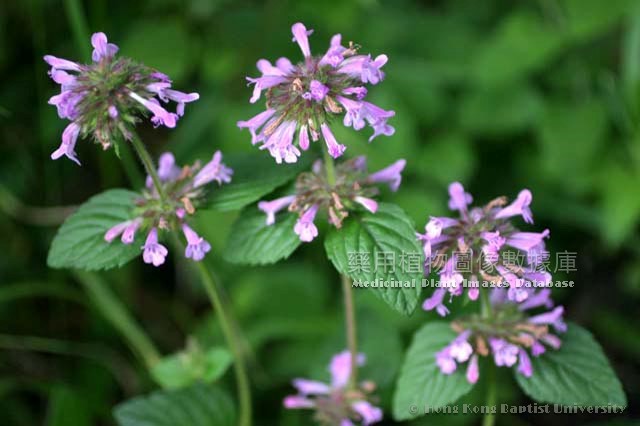|
Clinopodium chinense (Benth.) Kuntze

|
English Name |
Chinese Wildbasil, Chinese Clinopodium, Chinese Savory |
|
Latin name |
Clinopodium chinense (Benth.) Kuntze |
|
Family & Genus |
Lamiaceae, Clinopodium |
|
Description |
Perennial herbs, 1m tall. Stem repent, quadrangular, pubescent and glandular hairs. Leaves opposite; petioles 3-8mm long, densely pubescent; leaves ovate, 2-4cm long, 1-3cm wide, apex obtuse, base cuneate, margin round serrated, upper part with short bristles, lower part with sparse pubescence. Thyrsula dense on stem end, forming short raceme; no bracts; bract tubes ranging in width, with short bristles along the veins outside, the rest slightly pubescent, upper lip with 3 teeth, short, triangular, reflexed upward when fruiting, lower lip with 2 teeth, slightly longer, apex subulate, teeth with eyelashes; corolla white to purple red, about 1/2 times longer than calyx, slightly pubescent outside, apex of upper lip emarginated, lower lip 3 lobed, central lobes larger; stamens 4, front pair longer, sometimes back pair degenerated, only with front pair, anthers 2 chambers; ovary 4 lobed, stigma 2 lobed. Nutlets 4, ovoid, brown. Flowering: June to August, fruiting: July to September. |
|
Distribution |
Growing on hill-slopes at altitude 1,000m, tussock, roadsides, limesmarginis, thickets or under woods. Distributed in East China, Hubei, Hunan, Guangdong, Guangxi, Yunnan and etc. The medicinal materials are mainly produced in Hubei, Hunan, Guangdong, Guangxi, Shandong, Taiwan, Jiangsu, Anhui, Zhejiang, Jiangxi, Fujian and etc. |
|
Part Used |
Medical part: whole plant. Chinese name: Fengluncai. |
|
Harvest & Processing |
Harvested in autumn, summer, well washed, cut into segments, sun-dried or used fresh. |
|
Chemistry |
Whole plant contains triterpene saponin: saponinA; and flavonoid: didymin, hesperidin, isosakuranetin and aplolin, etc. |
|
Pharmacology |
Hemostatic, bacteriostatic; toxic. |
|
Properties & Actions |
Pungent, sweet, cool.Dispelling wind and clearing heat, removing toxin for detumescence and relieving hemorrhage. |
|
Indications & Usage |
Cold and pyrexia, sunstrokes, swelling pain of throat, diphtheria, acute cholecystitis, hepatitis, enteritis, dysentery.Oral administration: decocting, 10-15g; or smashed to extract juice. External application: appropriate amount, smashed for application; or decocted for washing. |
|
Examples |
1. Treat common cold with chills and fever: ceylon leucas herb 15g, Caesalpinia decapetala 6g. Decoct in water and swallow.
2. Treat diphtheria: whole herb of fresh Chinese wildbasil, pestle and collect juice, Drink 10-30 ml each time, every 2-4 hours. |
|

